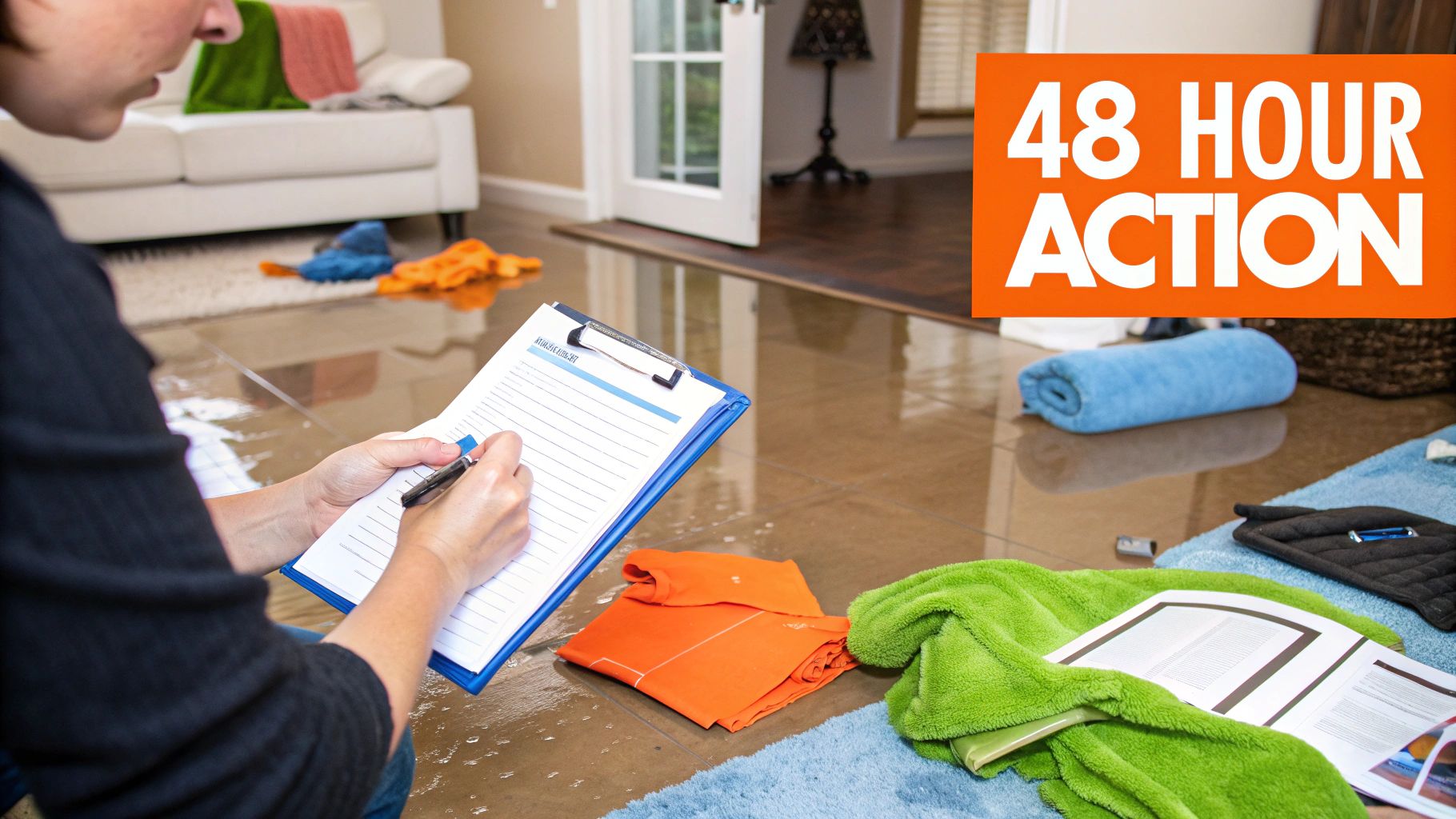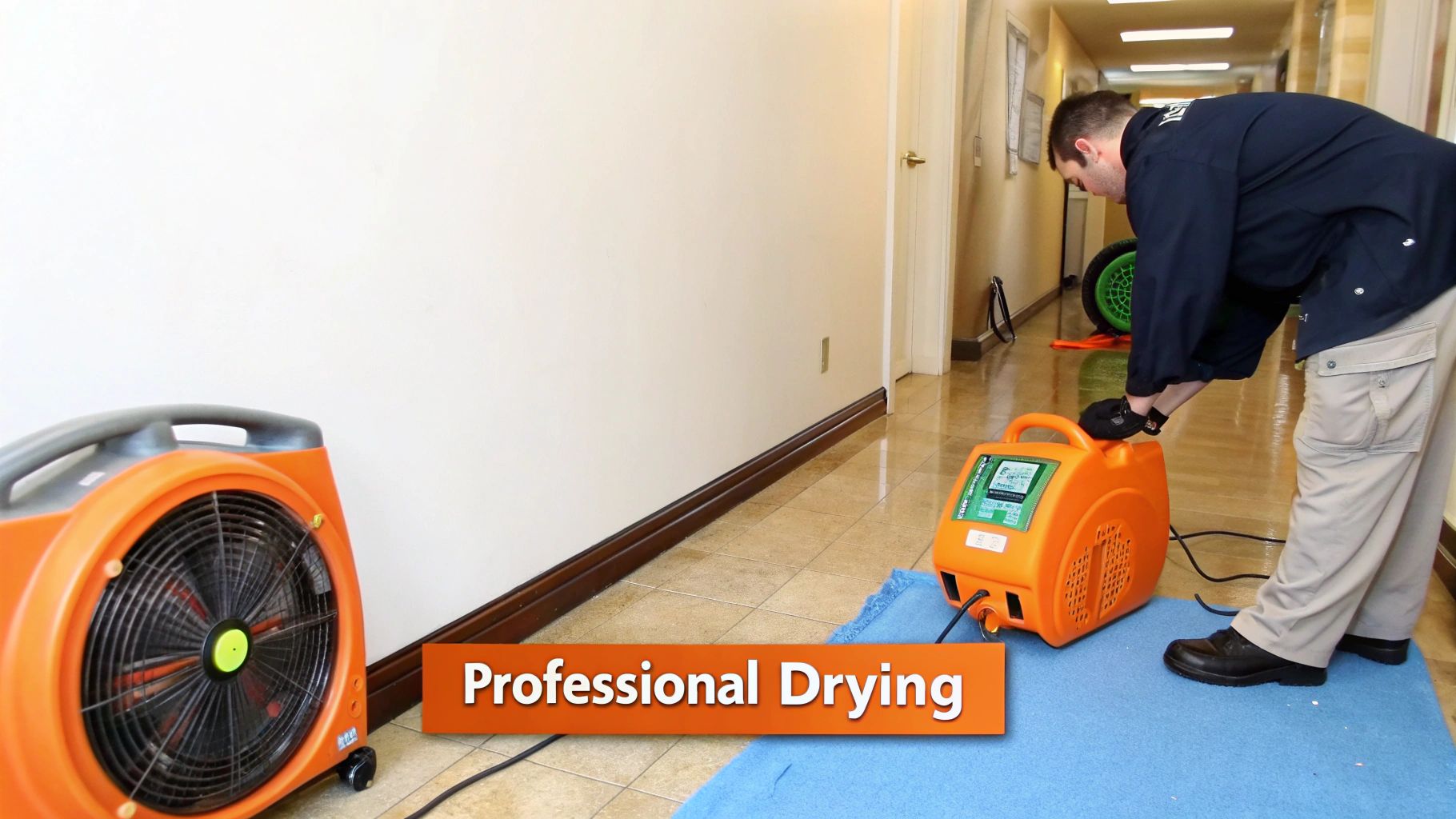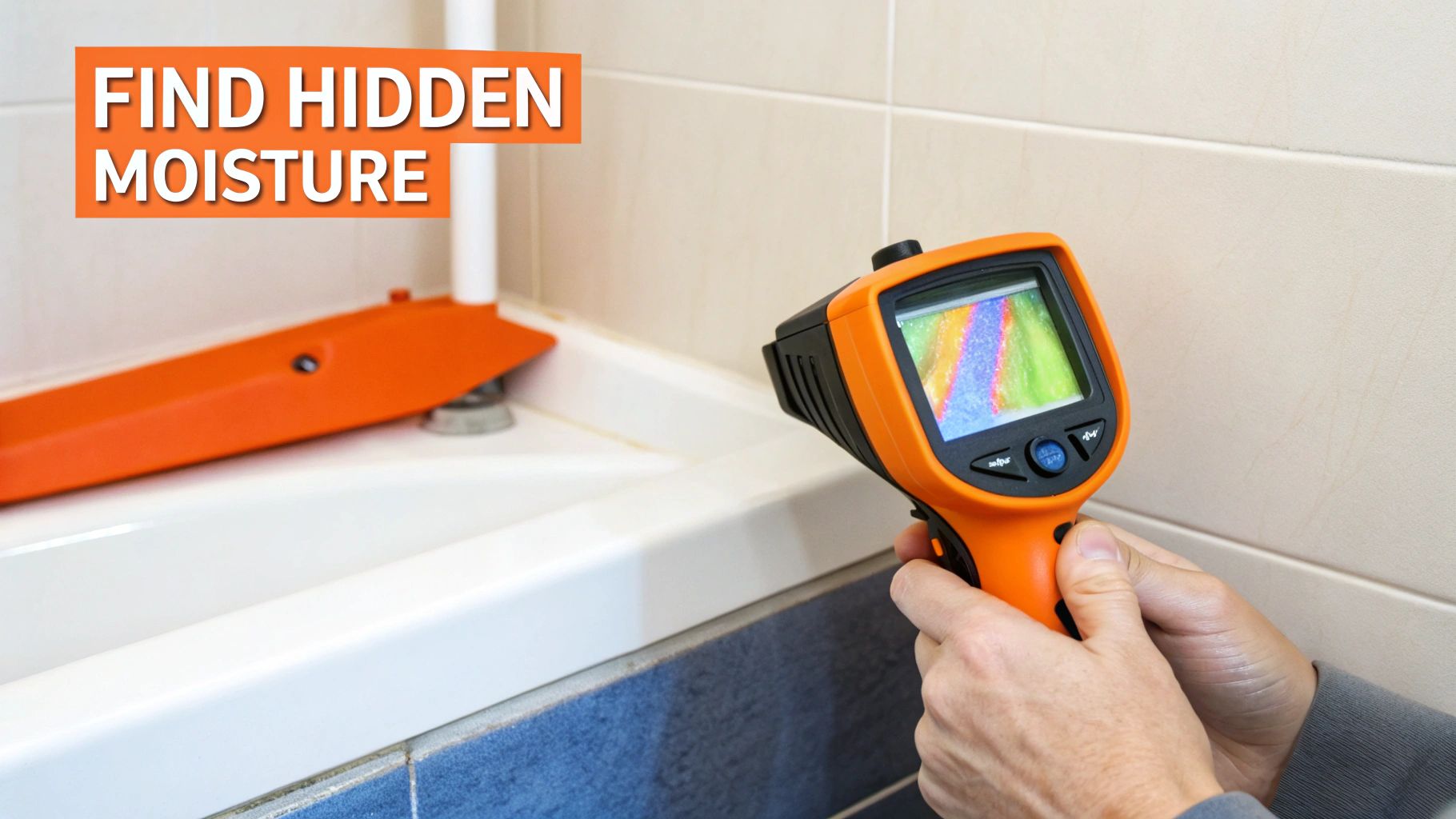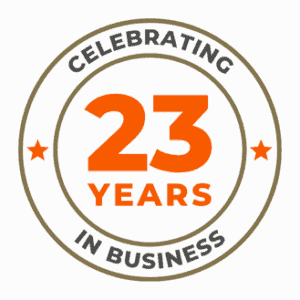When your property is hit with water damage, the clock becomes your biggest adversary. To effectively prevent mold after water damage, your primary mission is to get everything completely dry within 24 to 48 hours. This isn't just a recommendation; for homeowners and business owners across Orange County, it's the golden rule. Once moisture saturates porous materials like drywall, carpet, or wood, dormant mold spores—which are always present in our environment—receive the signal they need to activate and colonize.
That brief two-day window is what separates a manageable water damage event from a full-blown mold contamination crisis. Knowing how to act decisively can save you stress, time, and significant expense.
The First 48 Hours: Your Mold Prevention Timeline
Picture this: a pipe bursts in your Newport Beach home, or a dishwasher fails at your Irvine business. The moment water meets your structure, the countdown begins. Mold isn't a distant problem to be addressed next week; it's an immediate threat awaiting its opportunity.
Your first step is always to stop the water at its source. Knowing how to quickly turn off your home's water main is a fundamental skill that can save thousands in damages, preventing the situation from escalating while you plan your next move.
During this initial period, microscopic mold spores are actively seeking a damp surface to land. Once they find a suitable home on a wet material, they can begin to germinate almost immediately.
Why Time Is Not on Your Side
The science of mold growth is both straightforward and unforgiving. The U.S. Environmental Protection Agency (EPA) is unequivocal on this point: building materials must be thoroughly dried within the critical 24 to 48-hour window. We're talking about microscopic spores, sometimes just 2 to 100 microns in diameter, that effortlessly travel on air currents and settle on wet areas, creating colonies with startling speed.
This timeline provides a clear visual of just how quickly a simple water leak can escalate into a serious problem.
As you can see, by the 48-hour mark, mold is no longer a possibility—it's an active threat. At this stage, engaging an IICRC Master Certified professional becomes absolutely essential to protect your property and health.
Your Immediate Action Checklist
Standing in a flooded room can feel paralyzing. The chaos makes it difficult to know where to begin. To help you cut through the confusion, we’ve developed a quick-reference checklist. Focusing on these priorities will help you regain control and set the stage for a smooth, professional recovery.
Immediate Action Checklist For Water Damage
This table breaks down the crucial first steps to take within the first 24-48 hours. Acting quickly on these items will dramatically reduce the overall damage and help prevent mold from taking hold.
| Priority Action | Why It's Critical | Sparkle Pro Tip |
|---|---|---|
| Safety First | Shut off power at the breaker box for all affected areas. Water and electricity are a deadly combination. | If you must walk through standing water to access your breaker box, do not risk it. Call an electrician or the fire department immediately. |
| Stop the Water | Locate and shut off the main water valve to prevent any more water from flooding your property. | Every responsible adult in your home or business should know where the main water shut-off is and how to use it. Practice this before an emergency. |
| Document Everything | Before moving a single item, take extensive photos and videos of the damage for your insurance claim. | Capture wide shots of each room and close-ups of damaged items. Narrate your video to explain what you're seeing. This evidence is invaluable. |
| Call a Professional | Contact an IICRC Master Certified restoration company like Sparkle. An expert team can be onsite fast to begin extraction and drying. | Don't wait. The faster our professional crew begins setting up air movers and dehumidifiers, the better your chances of saving your property from mold. |
You can find more expert tips like these in our guide on creating a water emergency first-aid kit—an excellent resource to have on hand before disaster strikes.
At Sparkle Restoration Services, we’ve seen countless times how a client’s quick, informed actions in the first few hours dramatically reduced the scope of damage and cost of repairs. Your immediate response truly sets the tone for the entire recovery.
A Practical Guide to Drying Your Property Correctly
Once the initial chaos of a water leak or flood is contained, the real work begins. To prevent mold, you must get everything completely and verifiably dry. This process is far more involved than just mopping up the standing water you can see.
Moisture is insidious. It creeps deep into porous materials—drywall, wood studs, subflooring—creating hidden damp pockets that are a perfect five-star resort for mold spores.
Simply pointing a few household fans at a wet wall and hoping for the best is a recipe for disaster. Professional drying is a science. It involves strategically manipulating the environment to pull moisture out of saturated materials and then remove it from the air entirely. This is where professional-grade equipment and certified expertise become absolutely critical.

Creating a Professional Drying Environment
To restore a structure to a bone-dry state, IICRC-certified professionals like our team at Sparkle establish what’s known as a balanced drying system. It’s not about just blowing hot air around; it's a carefully orchestrated process using three key types of equipment working in harmony.
- High-Volume Air Movers: These are not your average fans. We strategically place these powerful units to create a vortex of airflow across wet surfaces. Their primary function is to accelerate evaporation, drawing moisture out of materials like carpets and drywall and converting it into airborne vapor.
- Low-Grain Refrigerant (LGR) Dehumidifiers: As soon as moisture becomes airborne, our industrial-strength dehumidifiers go to work. These are the heavy lifters of the operation, capable of pulling gallons of water vapor from the air, which is then safely drained away.
- Controlled Temperature: Heat plays a crucial role. Warmer air can hold significantly more moisture, which makes the entire dehumidification process far more efficient. We often use specialized heaters to create the optimal drying conditions.
Imagine a pipe bursting behind your kitchen wall here in Irvine. It soaks the drywall, the wooden studs, and your high-end custom cabinetry. To the naked eye, you might only see a small watermark. But our moisture meters would reveal that the entire wall cavity is saturated. Without this specialized drying system, that hidden moisture becomes a ticking time bomb for a major mold problem.
Measuring Success with Precision Tools
So, how do we know for certain when everything is dry? We don’t guess. Our technicians utilize an arsenal of precise instruments to track the drying progress and confirm that every affected material has returned to its normal, pre-damage moisture content.
The gap between "feeling dry" to the touch and being verifiably dry is where mold problems are born. Professional moisture meters provide the hard data to prove your property is safe.
We use specialized tools like penetrating and non-penetrating moisture meters to get dead-on accurate readings from all types of materials. For instance, knowing how to handle a water damage wood floor properly means understanding its exact moisture content to prevent warping or buckling. We establish a "dry standard" by taking readings from an unaffected area of your home, then monitor the wet zones daily until they meet that same baseline.
This meticulous, data-driven process is the hallmark of a true professional restoration company. It's how we, as a BBB Torch Award Winner, honor our commitment to ethics and excellence, ensuring we leave your Orange County property not just looking good, but truly, structurally, and safely dry.
Cleaning and Disinfecting Water Damaged Areas
Once the roar of the drying equipment subsides, it's tempting to think the worst is over. However, this next phase—deep cleaning and sanitization—is what truly safeguards your property from mold in the long term. This is about more than just wiping down surfaces; it’s about making the critical call on what can be salvaged versus what could jeopardize your home and health.
After significant water exposure, some materials are simply a lost cause. Saturated insulation, soaked carpet padding, and warped drywall become ideal breeding grounds for mold and bacteria if left in place. As a licensed General Contractor, we make the tough but essential decision to remove and dispose of these compromised materials. It’s the only way to ensure we’re rebuilding on a foundation that is clean, dry, and structurally sound.

Beyond Household Cleaners
One of the most common mistakes we see homeowners in Orange County make is reaching for bleach. While it feels like a powerful disinfectant, on porous materials like wood or drywall, it often causes more harm than good. The high water content in bleach soaks into the material, feeding the mold’s hidden root system, while the chlorine only disinfects the surface.
True sanitization requires professional-grade, EPA-approved antimicrobial treatments. These are formulated to eliminate microscopic mold spores and bacteria on contact—without adding more moisture to the problem.
Our IICRC-certified technicians apply these treatments methodically, adhering to strict safety protocols. This step is non-negotiable for creating a healthy indoor environment and is a core component of our commitment to doing the job right.
Salvaging and Treating Personal Items
For items that can be saved, we employ a tailored approach. Different materials require distinct cleaning methods to be effective without causing further damage.
- Hard Surfaces: Non-porous items like tile, metal fixtures, and solid wood furniture are first cleaned and then treated with powerful antimicrobial solutions.
- Soft Goods: Items like upholstered furniture, drapes, and area rugs need specialized care. To learn more about the professional techniques we use to restore these cherished possessions, you can explore our carpet and furniture cleaning services.
- Framing and Subfloors: Once structural components are fully dried and confirmed to be sound, we clean them thoroughly. In many cases, we also apply a mold-resistant coating to add another layer of long-term protection.
This careful, step-by-step cleaning process is what finally turns the chaos of water damage into the calm of a restored home. It guarantees that when we proceed to the restoration and remodeling phase, we are building on a structure that is not just dry, but truly clean and safe for your family or employees.
How Professionals Find Hidden Moisture Pockets
Just because a surface feels dry to the touch doesn't mean the water is gone. The real danger with any water intrusion is the moisture you can't see—the water that has worked its way behind walls, under floors, and into your home's structural cavities.
This is where mold thrives. It flourishes in dark, damp, hidden spaces, often spreading for weeks before a musty smell or a visible dark spot on the drywall finally reveals its presence. To confirm a structure is properly dry, we must look deeper. This is where our IICRC-certified expertise and advanced diagnostic tools allow us to see what the naked eye cannot.
The Technology That Sees Through Walls
To gain a complete understanding of the situation, we use sophisticated, non-invasive technology. This equipment allows us to map the full extent of the water damage with scientific precision, eliminating all guesswork.
- Thermal Imaging Cameras: These are invaluable tools. They don't "see" moisture directly; they detect minute temperature differences. Wet materials are almost always cooler than dry ones due to evaporation. Our cameras display these temperature variations as different colors, instantly revealing hidden damp spots behind drywall or under expensive flooring without requiring a single incision.
- Non-Invasive Moisture Meters: These devices are equally critical. They use radio frequencies to measure the moisture content inside a material without piercing its surface. We can slide one across a wall or hardwood floor to get instant readings, allowing us to create a detailed "moisture map" of the entire affected area.
This combination of tools is what distinguishes a truly professional restoration from a superficial one. Technology like this has revolutionized how we approach water damage, enabling far more precise and effective mold prevention. For those interested in the industry's technological advancements, you can review some recent market research on mold remediation services.
A Real-World Newport Beach Scenario
Imagine a slow leak from a shower valve in a Newport Beach home—the kind that goes unnoticed for weeks. On the surface, the wall appears perfectly fine. But when we aim our thermal camera at it, we might see a large, cool blue area spreading down the wall in the adjacent room, signaling a significant hidden moisture problem.
From there, we would use our moisture meters to confirm the saturation levels and pinpoint the exact boundaries of the damage. This detailed data enables us to create a highly targeted drying plan, focusing our equipment precisely where it's needed most. You can see how we apply these principles on our job sites, like in this recent water damage mitigation and restoration in Irvine, CA.
Without this technology, that hidden leak could have silently nurtured a massive mold colony for months, leading to extensive structural damage and a much more complex and costly remediation project. A professional assessment is your best defense against the unseen.
Long-Term Strategies for a Mold-Free Home
Once the dust has settled and the immediate crisis of water damage is resolved, the focus must shift from reaction to prevention. Preventing mold is not a one-time cleanup; it’s an ongoing commitment to the health of your home.
For homeowners here in Orange County, our coastal humidity presents a constant factor that can work against us. That’s why maintaining a vigilant, proactive approach is the only way to truly protect your investment and ensure a safe indoor environment. It's about adopting smart, routine maintenance habits.

This shift in mindset is what separates property owners who are constantly fighting problems from those who prevent them from ever starting.
Control Your Indoor Climate
Your most powerful weapon against mold is controlling indoor humidity. The principle is simple: mold needs moisture to survive. If you create an environment where it cannot gain a foothold, you win.
In Southern California, the ideal range for indoor humidity is between 30% and 50%. Anything higher, and you are effectively rolling out the welcome mat for mold.
Keeping your indoor humidity level below 50% is arguably the most effective long-term strategy you can adopt. It makes your home an actively hostile environment for mold spores trying to colonize.
You don't have to guess. An inexpensive digital hygrometer from any hardware store will provide an accurate reading. If you notice those numbers creeping up, especially after a hot shower or while cooking, it's time to act.
- Boost Your Ventilation: Always use the exhaust fans in your bathrooms and kitchen. Don't turn them off the moment you're done; let them run for an additional 20-30 minutes to exhaust all damp air outside.
- Bring in a Dehumidifier: For chronically damp areas—like laundry rooms, basements, or a bathroom without a window—a quality dehumidifier is a game-changer. It’s a small investment that pays huge dividends in indoor air quality.
These are not drastic measures; they are simple habits that make a massive difference in managing your home's moisture load year-round.
Perform Routine Property Inspections
Small leaks and minor drips have a way of escalating into catastrophic problems when left unaddressed. The key to a mold-free home is catching these issues before they escalate. I always advise my clients to conduct a thorough walk-through of their property at least twice a year.
Your Seasonal Maintenance Checklist:
- Check Under Sinks: Use a flashlight to inspect the inside of your kitchen and bathroom cabinets. Look for subtle signs of a slow drip, water stains, or warped cabinet floors.
- Inspect Appliance Hoses: The rubber hoses on your washing machine and dishwasher do not last forever. Look for cracks, brittleness, or any bulging—these are clear warning signs.
- Examine Window Seals: Check the caulking and seals around your windows. If they're cracked or peeling, moisture can easily seep in during the next rainstorm.
- Clean Your Gutters: This is critical. Clogged gutters force rainwater to overflow, often sending it down your walls and into your foundation. Keep them clear.
Remodel with Mold-Resistance in Mind
For a truly permanent solution, consider mold resistance the next time you plan a renovation. As a Licensed General Contractor specializing in luxury remodels, this is something we integrate into our projects from day one.
Instead of simply replacing damaged materials with the same standard products, upgrade. Using materials like mold-resistant drywall in bathrooms, installing waterproof flooring, and applying high-quality exterior sealants creates a robust, long-term barrier. It’s an investment that secures your home’s health and protects its value for years to come.
Got Questions About Mold After a Leak? We’ve Got Answers.
When Orange County homeowners are facing the aftermath of water damage, a flood of questions and worries is never far behind. As a BBB Torch Award Winner for Ethics, our role is to provide clear, honest answers to guide you through this stressful time.
Here are a few of the questions we answer almost every day.
Can I Just Pour Bleach on the Mold?
This is easily the most persistent myth we have to bust. While bleach might appear to work on the surface of non-porous items like tile, the EPA strongly advises against using it on porous materials such as drywall, wood, or carpet.
The problem is that bleach is mostly water. When applied to drywall, that water soaks deep into the material and can actually feed the mold’s root system (the mycelia). The surface mold may disappear temporarily, but it often returns with a vengeance.
To eliminate mold for good, you need professional-grade, EPA-approved antimicrobials that kill the problem at its source without adding more moisture to the equation.
How Can I Be Sure an Area Is Completely Dry?
Trusting your sense of touch is a recipe for disaster. A wall can feel bone dry on the surface while still hiding enough moisture deep inside to become a breeding ground for a hidden mold colony. Guessing is your worst enemy in this situation.
The only way to know for sure is with professional-grade instruments. Our IICRC-certified technicians don't guess; we use thermal imaging cameras to see temperature differences that indicate moisture and calibrated moisture meters to get exact readings from inside walls and under floors. We document everything to prove your property has been returned to its safe, pre-damage condition.
That lingering musty smell? It's a huge red flag, even if you don't see a single spot of mold. That earthy odor comes from Microbial Volatile Organic Compounds (MVOCs), which are gases released by active mold colonies. It’s your nose telling you there’s a hidden problem that needs a professional look.
Is That Musty Smell Really a Sign of Mold?
Yes, it absolutely is. If you have a persistent musty or earthy odor, you should never ignore it. It is one of the most reliable indicators of microbial growth.
Mold loves to grow where you can't see it—behind wallpaper, tucked under carpet padding, or inside a wall cavity after a pipe leak. That smell is often the very first clue that something is wrong. If you smell it, it's time to call for a professional inspection to find the hidden moisture source and stop the mold before it spreads.
For more on this topic, it's worth reviewing some common facts and myths about mold remediation.
Does My Insurance Company Get to Pick My Restoration Contractor?
No. In California, the law is on your side. You have the absolute right to choose the restoration company you want to work with, regardless of who your insurance provider may suggest.
It's critical to hire a company with proven expertise, the right credentials (like being IICRC Master Certified), and a sterling reputation in your community. We handle the entire claims process for you, working directly with all insurance carriers to ensure your home is restored to the highest standard—not just the cheapest one. Your peace of mind is our top priority.
When you're facing water damage, you need a partner with the skill and integrity to do the job right the first time. The IICRC Master Certified team at Sparkle Restoration Services has been proudly serving Orange County since 2002, turning chaos into calm with unmatched professionalism and a commitment to excellence.

